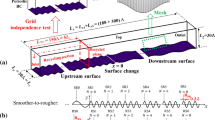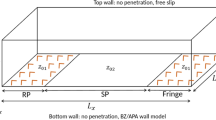Abstract
A wind-tunnel experiment was designed and carried out to study the effect of a surface roughness transition on subfilter-scale (SFS) physics in a turbulent boundary layer. Specifically, subfilter-scale stresses are evaluated that require parameterizations and are key to improving the accuracy of large-eddy simulations of the atmospheric boundary layer. The surface transition considered in this study consists of a sharp change from a rough, wire-mesh covered surface to a smooth surface. The resulting magnitude jump in aerodynamic roughnesses, M = ln(z 01/z 02), where z 01 and z 02 are the upwind and downwind aerodynamic surface roughnesses respectively, is similar to that of past experimental studies in the atmospheric boundary layer. The two-dimensional velocity fields used in this study are measured using particle image velocimetry and are acquired at several positions downwind of the roughness transition as well as over a homogeneous smooth surface. Results show that the SFS stress, resolved strain rate and SFS transfer rate of resolved kinetic energy are dependent on the position within the boundary layer relative to the surface roughness transition. A mismatch is found in the downwind trend of the SFS stress and resolved strain rate with distance from the transition. This difference of behaviour may not be captured by some eddy-viscosity type models that parameterize the SFS stress tensor as proportional to the resolved strain rate tensor. These results can be used as a benchmark to test the ability of existing and new SFS models to capture the spatial variability SFS physics associated with surface roughness heterogeneities.
Similar content being viewed by others
References
Albertson JD and Parlange MB (1999). Surface length scales and shear stress: implications for land-atmosphere interaction over complex terrain. Water Resour Res 35: 2121–2132
Andrén JC and Blondin C (1986). On the effective roughness length for use in numerical three-dimensional models. Boundary-Layer Meteorol 35: 231–245
Antonia RA and Luxton RE (1971). The response of a turbulent boundary layer to a step change in surface roughness: part 1. Smooth to rough. J Fluid Mech 48: 721–761
Antonia RA and Luxton RE (1972). The response of a turbulent boundary layer to a step change in surface roughness: part 2. Rough to smooth. J Fluid Mech 53: 735–757
Avelino MR (2000). An experimental/numerical study of the turbulent boundary layer development along a surface with a sudden change of roughness. J Braz Soc Mech Sci 22(1): 1–17
Avissar R and Schmidt T (1998). An evaluation of the scale at which ground-surface heat flux patchiness affects the convective boundary layer using large-eddy simulations. J Atmos Sci 55: 2666–2689
Bou-Zeid E, Meneveau C and Parlange MB (2004). Large-eddy simulation of neutral atmsopheric boundary layer flow over heterogeneous surfaces: blending height and effective surface roughness. Water Resour Res 40: 1–18
Bou-Zeid E, Meneveau C, Parlange MB (2005) A scale-dependent lagrangian dynamic model for the large-eddy simulation of complex turbulent flows. Phys Fluids 17:025105, 1–18
Bradley EF (1968). A micrometeorological study of the velocity profiles and surface drag in the region modified by a change in surface roughness. Quart J Roy Meteorol 94: 361–379
Brutsaert WH (1998). Land-surface water vapor and sensible heat flux: spatial variability, homogeneity and measurement scales. J Atmos Sci 34: 2433–2442
Carper MA and Porté-Agel F (2004). The role of coherent structures in subfilter-scale dissipation of turbulence measured in the atmospheric surface layer. J Turbulence 5(40): 1–24
Castro IP, Cheng H and Reynolds R (2006). Turbulence over urban-type roughness: deductions from wind-tunnel measurements. Boundary-Layer Meteorol 118: 109–131
Chen J, Katz J and Meneveau C (2005). Implication of mismatch between stress and strain-rate in turbulence subjected to rapid straining and destraining on dynamic LES models. J Fluids Eng 127: 840–850
Cheng H and Castro IP (2002). Near-wall flow development after a step change in surface roughness. Boundary-Layer Meteorol 105: 411–432
Elliot WP (1958). The growth of the atmospheric internal boundary layer. Eos Trans AGU 39: 1048–1054
Garratt JR (1990). The internal boundary layer—a review. Boundary-Layer Meteorol 109: 59–83
Geurts BJ (2004). Elements of direct and large-eddy simulation. Edwards, Philadelphia, 329 pp
Glendening JW and Lin C-L (2002). Large eddy simulation of internal boundary layers created by a change in surface roughness. J Atmos Sci 59: 1697–1711
Hobson JM, Wood N and Brown AR (1999). Large-eddy simulations of neutrally stratified flow over surfaces with spatially varying roughness length. Quart J Roy Meteorol Soc 125: 1937–1958
Jimenez J (2004). Turbulent flows over rough walls. Annu Rev Fluid Mech 36: 173–196
Kaimal JC and Finnigan JJ (1994). Atmospheric Boundary Layer Flows. Oxford Univ Press, New York, 289
Lin C-L and Glendening JW (2002). Large-eddy simulation of an inhomogeneous atmospheric boundary layer under neutral conditions. J Atmos Sci 59: 2479–2497
Liu S, Meneveau C and Katz J (1994). On the properties of similarity subgrid-scale models as deduced from measurements in a turbulent jet. J Fluid Mech 275: 83–119
Meneveau C and Katz J (2000). Scale-invariance and turbulence models for large-eddy simulation. Annu Rev Fluid Mech 32: 1–32
Mulhearn PJ (1977). Relations between surface fluxes and mean profiles of velocity, temperature and concentration, downwind of a change in surface roughness. Quart J Roy Meteorol Soc 103(438): 785–802
Mulhearn PJ (1978). A wind-tunnel boundary-layer study of the effects of a surface roughness change: rough-to-smooth. Boundary-Layer Meteorol 15: 3–30
Panofsky HA and Townsend AA (1964). Change of terrain roughness and the wind profile. Quart J Roy Meteorol Soc 90: 147–155
Perry AE, Lim KL and Henbest SM (1987). An experimental study of the turbulence structure in smooth- and rough-wall boundary layers. J Fluid Mech 177: 437–466
Piomelli U, Cabot WH, Moin P and Lee S (1991). Subgrid-scale backscatter in turbulent and transitional flows. Phys Fluids 3(7): 1766–1771
Pope SB (2000). Turbulent Flows. Cambridge University Press, Cambridge, UK, New York, 771
Porté-Agel F, Parlange MB, Meneveau C and Eichinger WE (2001). A-priori field study of the subgrid-scale heat fluxes and dissipation in the atmospheric surface layer. J Atmos Sci 58: 2673–2698
Raffel M, Willert E, Kompenhans J (1997) Particle image velocimetry: a practical guide. Springer-Verlag, 253 pp
Roy SB and Avissar R (2000). Scales of response of the convective boundary layer to land-surface heterogeneity. Geophys Res Letters 27(4): 533–536
Schlichting H (1979). Boundary-Layer Theory. McGraw-Hill, New York, 817 pp
Schofield WH (1975). Measurements in adverse-pressure-gradient turbulent boundary layers with a step change in surface roughness. J Fluid Mech 70: 573–593
Stoll R, Porté-Agel F (2006) Dynamic subgrid-scale models for momentum and scalar fluxes in large-eddy simulations of neutrally stratified atmospheric boundary layers over heterogeneous terrain. Water Resour Res 42:W01409, 1–18
Taylor PA (1987). Comments and further analysis on effective roughness lengths for use in numerical three-dimensional models. Boundary-Layer Meteorol 39: 403–418
Walmsley (1989). Internal boundary-layer height formulae—a comparison with atmospheric data. Boundary-Layer Meteorol 47: 251–262
Westerweel J (1997). Fundamentals of digital particle image velocimetry. Meas Sci Technol 8: 1379–1392
Wieringa J (1976). An objective exposure correction method for average wind speeds measured at a shelter location. Quart J Roy Meteorol Soc 102: 241–253
Wong VC and Lilly DK (1994). A comparison of two dynamic subgrid closure methods for turbulent thermal convection. Phys Fluids 6(2): 1016–1023
Wood DH (1982). Internal boundary layer growth following a step change in surface roughness. Boundary-Layer Meteorol 22: 241–244
Author information
Authors and Affiliations
Corresponding author
Rights and permissions
About this article
Cite this article
Carper, M.A., Porté-Agel, F. Subfilter-scale Fluxes over a Surface Roughness Transition. Part I: Measured Fluxes and Energy Transfer Rates. Boundary-Layer Meteorol 126, 157–179 (2008). https://doi.org/10.1007/s10546-007-9228-z
Received:
Accepted:
Published:
Issue Date:
DOI: https://doi.org/10.1007/s10546-007-9228-z




